
Manual Lab Press
Laboratory Manual Hydraulic Pellet Press for Lab Use
Item Number : PCF
Price varies based on specs and customizations
- Working pressure
- 0-60 T
- Piston diameter
- 80-150 mm
- Piston stroke
- 30- 50 mm
- Gauge range
- 0-40 Mpa
Shipping:
Contact us to get shipping details Enjoy On-time Dispatch Guarantee.
Why Choose Us
Reliable PartnerEasy ordering process, quality products, and dedicated support for your business success.
Applications
Hydraulic press is widely used in material researching labs,pharmacy,catalytic reaction,ceramics, electronic industries, it is one high efficient equipment for the sample preparing, due to its small footprint, it easy to carry and move, can work inside the vacuum glove box for processing under vacuum environment. Hydraulic press can also process hot press function with heating plates, which can serve the particular material processing
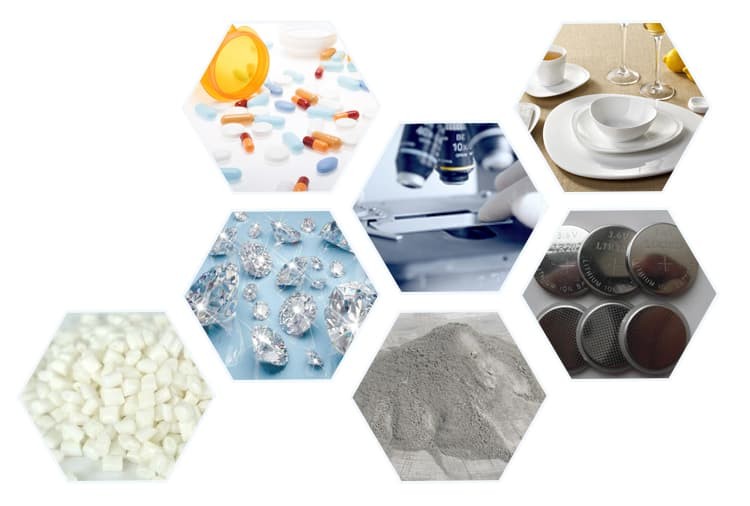
Feature
Protective Manual Lab Hydraulic Press offer better protection than regular tablet presses.
- The Protective Manual Lab Hydraulic Press is suitable for some brittle material molds or molds that require super pressure。
- Pressure gauge with double pressure indicator, save pressure converting time。
- Suitable for laboratories or organizations with high safety requirements, and is designed to meet European and American safety standards.
- 15-24T model machine output sample can meet requirement of infrared spectrometer
- 24-40T model machine output sample can meet requirement of fluorescence spectrometer
- Safety protection cover is essential for brittle or super pressure materials of the press dies
- Safety protection cover material applies Polymethyl methacrylate, shocking and cracking proof
Protective Manual Lab Hydraulic Press above 60T can be designed according to your needs.
Advantages
- The upper plate adopts electroplated countersunk head hexagonal screws, beautiful and space-saving
- Chrome-plated cylinder, smooth surface, no rust, good sealing rubber ring, no oil leakage
- One-piece main board structure, oil pool, main board, oil cylinder in a body, no seal connection
- Extended pulling spring, good rebound effect, not easy to deformation, can achieve the cylinder 30mm return without deformation
- All aluminum alloy hand wheel, beautiful, practical, not easy to break
- Small size, light weight, no oil leakage, can be used in the glove box
- Mold using Japanese high-speed steel, good material, high hardness, no deformation, long service life
- Digital display pressure gauge, more accurate pressure control, pressure display accuracy of 0.01MPa
- Oil pool outside the host, easy to replace the oil, and the oil circuit increased the hydraulic oil filtration device
- Special plunger, using special custom sealing structure, excellent sealing effect
- Pressurizing device, placed in the lowermost corner of the mainframe, the angle is reasonable, pressurizing force does not tilt back
Detail & Parts
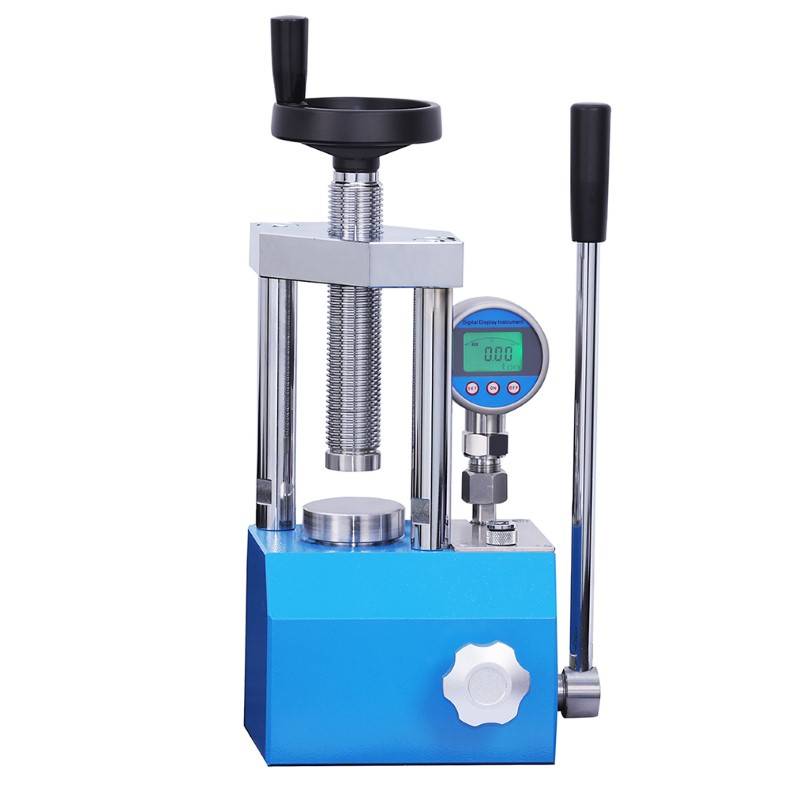
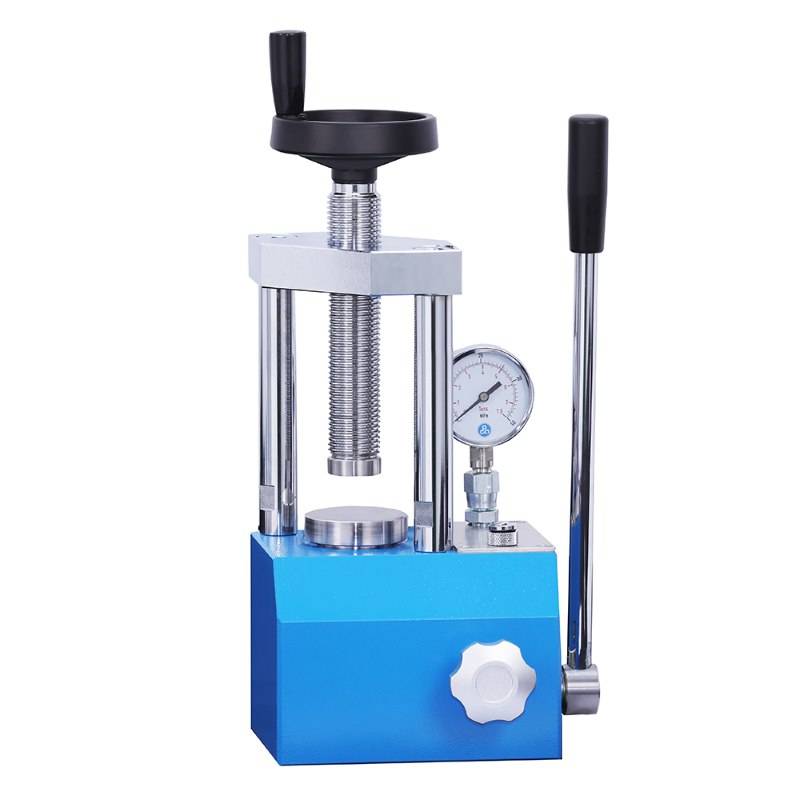

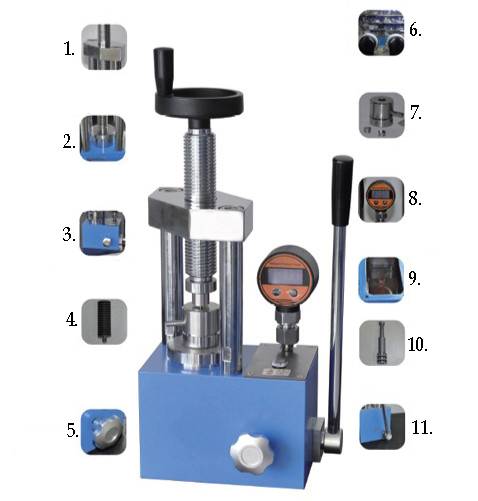
- Top board uses electroplated countersunk socket head cap screws, which are beautiful, space saving and smooth.
- Chrome-plated oil cylinder features smooth surface, rust prevention, excellent rubber gasket sealing and leakage-proof.
- Oil sump, mainboard and oil cylinder are integrated on the same mainboard, and no sealing connection is needed.
- Extended tension spring with excell-entresilience ensures that the oil cylinder won't deform easily in 30mm return trip.
- Aluminum alloy hand-wheel,beautiful,practical,sturdy and durable.
- Small size, light weight,leak-proof, easy to handle,suitable for use in glove box.
- Dies are made of quick-cutting steel imported from Japan, featuring quality material, high hardness, non-deformation and long life.
- Digital pressure gauge offers pressure control as accurate as 0.01MPa.
- 0il sump is on the surface of the main unit to facilitate oil cha -nging, and hydraulic filter is installed in the oil circuit.
- Dedicated plunger uses specially customized structure to ensure sealing effect and prevent leakage.
- Pressure device Is placed in the bottom of the main unit, which ensures reasonable angle and saves pressurizing force.
Technical specifications
| Instrument model | PCF-15T | PCF-24T | PCF-30T | PCF-40T | PCF-60T |
|---|---|---|---|---|---|
| Pressure range | 0-15T(0-30MPa) | 0-24T(0-34MPa) | 0-30T(0-31.5MPa) | 0-40T(0-30MPa) | 0-60T(0-34MPa) |
| Piston diameter | Φ80mm (d) | Φ95mm (d) | Φ110mm (d) | Φ130mm (d) | Φ150mm (d) |
| Pressure gauge | Pressure and pressure intensity display | Pressure and pressure intensity display | Pressure and pressure intensity display | Pressure and pressure intensity display | Pressure and pressure intensity display |
| Maximum pressure (T) | 30mm | 30mm | 40mm | 50mm | 50mm |
| Protective cover | Plexiglass | Plexiglass | Plexiglass | Plexiglass | Plexiglass |
| Pressure stability | ≤1MPa/10min | ≤1MPa/10min | ≤1MPa/10min | ≤1MPa/10min | ≤1MPa/10min |
| Workbench diameter | Φ90mm (D) | Φ105mm (D) | Φ120mm (D) | Φ140mm (D) | Φ160mm (D) |
| Number of columns | Four | Four | Four | Four | Four |
| Working space | 80××130mm(M×N) | 112×160mm(M×N) | 112×160mm(M×N) | 126×185mm(M×N) | 185×250mm(M×N) |
| Dimensions | 260×175×395mm(L×W×H) | 305×195×425mm(L×W×H) | 305×195×425mm(L×W×H) | 355×215×505mm(L×W×H) | 405×240×565mm(L×W×H) |
| Weight | 42Kg | 65Kg | 65Kg | 90Kg | 120Kg |

Volume: The tablet press is small in size, light in weight, does not leak oil, is easy to transport, and can be placed in the glove box for use.
Structure: One-piece mainboard structure, oil pool, mainboard, and oil cylinder are on one main body, without sealed connections to reduce oil leakage.
Accuracy: It can be equipped with a digital pressure gauge, the pressure control is precise, and the pressure display accuracy is 0.01MPa.
Die

Pressure Conversion
| Force | Pressure |
|---|---|
| 1[Tons] | 0.75[MPa] |
| 3[Tons] | 2.2[MPa] |
| 5 [Tons] | 3.7[MPa] |
| 10[Tons] | 7.5[Mpa] |
| 12[Tons] | 9[MPa] |
| 15[Tons] | 11.3[MPa] |
| 20[Tons] | 15[MPa] |
| 30[Tons] | 22.5[MPa] |
| 40[Tons] | 30[MPa] |
| Note: The system pressure intensity shouldn't exceed 35 MPa, or else it will shorten the service life of the equipment. | |
Operation
How to replace accessories and precautions
Before we dive into the step-by-step instructions, it's essential to note that safety is of utmost importance when operating the Manual lab press machine. Always wear protective gloves and eye goggles when handling the machine, and make sure to read the user manual carefully before use.

Step 1: Place the mold in the center of the tablet press

Step 2: Tighten the tablet press oil drain valve clockwise

Step 3: Tighten the screw to fix the mold

Step 4: Shake the handle pressure rod back and forth to reach the required pressure

Step 5: Loosen the oil drain valve counterclockwise to release the pressure

Step 6: Remove the pressed mold from the tablet press
Full range of lab press types
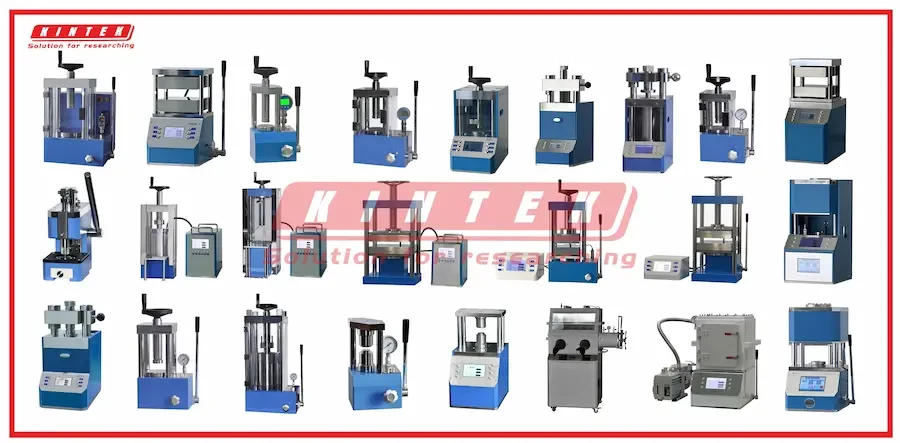
Click to view our full range of lab press products.
Any question? Our experts have helped many laboratories choose their lab press, contact us now!
Full range of types of laboratory press molds
We have a full range of molds for you to choose from, and the molds fit the body perfectly.
If you need molds with special shapes, we can also customize them for you.
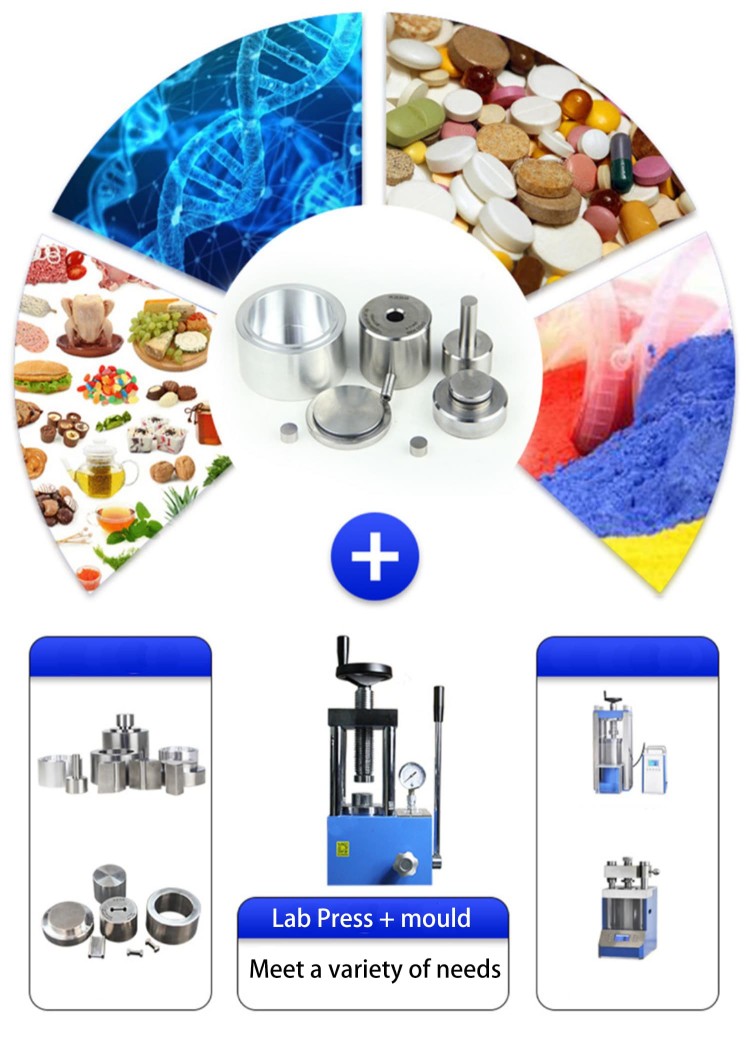
Warnings
Operator safety is the top important issue! Please operate the equipment with cautions. Working with inflammable& explosive or toxic gases is very dangerous, operators must take all necessary precautions before starting the equipment. Working with positive pressure inside the reactors or chambers is dangerous, operator must fellow the safety procedures strictly. Extra caution must also be taken when operating with air-reactive materials, especially under vacuum. A leak can draw air into the apparatus and cause a violent reaction to occur.
Designed for You
KinTek provide deep custom made service and equipment to worldwide customers, our specialized teamwork and rich experienced engineers are capable to undertake the custom tailoring hardware and software equipment requirements, and help our customer to build up the exclusive and personalized equipment and solution!
Would you please drop your ideas to us, our engineers are ready for you now!
FAQ
What Is A Lab Press?
What Are The Applications Of Pellet Presses?
What Is The Purpose Of A Hydraulic Press In Lab?
How Does A Pellet Press Work?
What Are Different Type Of Lab Presses?
What Is KBr Used For?
What Are The Benefits Of Using A Pellet Press?
What Is The KBr Pellet Method?
What Factors Should Be Considered When Selecting A Pellet Press?
Why KBr Is Used For Pellet?
How To Make KBr Pellets For FTIR?
4.9
out of
5
This Manual Lab Hydraulic Pellet Press is an awesome time saver. It's easy to use and makes creating high-quality pellets a breeze.
4.8
out of
5
I was amazed by the quality of this press. It's sturdy and well-built, and it produces consistent, high-quality pellets every time.
4.7
out of
5
This press is a great value for the money. It's easy to operate and maintain, and it's perfect for our lab's needs.
4.9
out of
5
I'm so glad I purchased this press. It's made my work so much easier and more efficient.
4.8
out of
5
This press is a must-have for any lab that needs to produce high-quality pellets. It's a great investment that will pay for itself in no time.
4.7
out of
5
I was skeptical at first, but this press has exceeded my expectations. It's easy to use and produces excellent results.
4.9
out of
5
This press is a game-changer for our lab. It's made our work so much faster and easier.
4.8
out of
5
I'm really impressed with this press. It's well-made and produces consistent, high-quality pellets.
4.7
out of
5
This press is a great addition to our lab. It's easy to use and has helped us improve the quality of our pellets.
4.9
out of
5
I'm so glad I found this press. It's made my work so much easier and more efficient.
4.8
out of
5
This press is a great value for the money. It's easy to operate and maintain, and it's perfect for our lab's needs.
4.7
out of
5
I'm so glad I purchased this press. It's made my work so much easier and more efficient.
4.9
out of
5
This press is a must-have for any lab that needs to produce high-quality pellets. It's a great investment that will pay for itself in no time.
4.8
out of
5
I was skeptical at first, but this press has exceeded my expectations. It's easy to use and produces excellent results.
4.7
out of
5
This press is a game-changer for our lab. It's made our work so much faster and easier.
REQUEST A QUOTE
Our professional team will reply to you within one business day. Please feel free to contact us!
Related Products

Laboratory Manual Hydraulic Pellet Press for Lab Use
Efficient sample preparation with small footprint Manual Lab Hydraulic Press. Ideal for material researching labs, pharmacy, catalytic reaction, and ceramics.

Introducing the KINTEK KBR Press - a handheld laboratory hydraulic press designed for entry-level users.

Laboratory Hydraulic Press Lab Pellet Press Machine for Glove Box
Controlled environment lab press machine for glove box. Specialized equipment for material pressing and shaping with high precision digital pressure gauge.

Laboratory Hydraulic Pellet Press for XRF KBR FTIR Lab Applications
Efficiently prepare samples with the Electric Hydraulic Press. Compact and portable, it's perfect for labs and can work in a vacuum environment.

Automatic Heated Hydraulic Press Machine with Heated Plates for Laboratory Hot Press 25T 30T 50T
Efficiently prepare your samples with our Automatic Heated Lab Press. With a pressure range up to 50T and precise control, it's perfect for various industries.

Heated Hydraulic Press Machine with Integrated Manual Heated Plates for Lab Use
Efficiently process heat-pressing samples with our Integrated Manual Heated Lab Press. With a heating range up to 500°C, it's perfect for various industries.

Heated Hydraulic Press Machine with Heated Plates Split Manual Laboratory Hot Press
Efficiently prepare your samples with our Split Manual Heated Lab Press. With a pressure range up to 40T and heating plates up to 300°C, it's perfect for various industries.

Laboratory Hydraulic Press Lab Pellet Press for Button Battery
Efficiently prepare samples with our 2T Button Battery Press. Ideal for material research labs and small-scale production. Small footprint, lightweight, and vacuum-compatible.

Manual Heated Hydraulic Press Machine with Heated Plates for Laboratory Hot Press
The Manual Heat Press is a versatile piece of equipment suitable for a variety of applications, operated by a manual hydraulic system that applies controlled pressure and heat to the material placed on the piston.

Heated Hydraulic Press Machine with Heated Plates for Vacuum Box Laboratory Hot Press
Enhance your lab's precision with our lab press for vacuum box. Press pills and powders with ease and precision in a vacuum environment, reducing oxidation and improving consistency. Compact and easy to use with a digital pressure gauge.

Electric Heated Hydraulic Vacuum Heat Press for Lab
The Electric Vacuum Heat Press is a specialized heat press equipment that operates in a vacuum environment, utilizing advanced infrared heating and precise temperature control for high quality, rugged and reliable performance.

Automatic Heated Hydraulic Press Machine with Heated Plates for Laboratory Hot Press
The Automatic High Temperature Heat Press is a sophisticated hydraulic hot press designed for efficient temperature control and product quality processing.

Laboratory Hydraulic Press Split Electric Lab Pellet Press
Efficiently prepare samples with a split electric lab press - available in various sizes and ideal for material research, pharmacy, and ceramics. Enjoy greater versatility and higher pressure with this portable and programmable option.

Heated Hydraulic Press Machine with Heated Plates for Vacuum Box Laboratory Hot Press
The lab press for vacuum box is a specialized piece of equipment designed for laboratory use. Its main purpose is to press pills and powders according to specific requirements.

Explore versatile Hydraulic Hot Press molds for precise compression molding. Ideal for creating various shapes and sizes with uniform stability.

Laboratory Vertical Water Circulating Vacuum Pump for Lab Use
Looking for a reliable water circulating vacuum pump for your lab or small-scale industry? Check out our Vertical Water Circulating Vacuum Pump with five taps and a larger air sucking amount, perfect for evaporation, distillation, and more.

1700℃ Controlled Atmosphere Furnace Nitrogen Inert Atmosphere Furnace
KT-17A Controlled atmosphere furnace: 1700℃ heating, vacuum sealing technology, PID temperature control, and versatile TFT smart touch screen controller for laboratory and industrial use.
Related Articles

Manual Hydraulic Presses for Laboratory Use: A Comprehensive Guide
Explore the intricacies of manual hydraulic presses in labs, including operation, benefits, and comparison with automatic models. Ideal for those seeking detailed insights on sample preparation and cost-effectiveness.

Hydraulic Tablet Press: Comprehensive Guide to Design, Operation, and Applications
Explore the advanced features, operational principles, and diverse applications of hydraulic tablet presses in various industries. Learn how these machines ensure high-quality tablet production with detailed insights.

Manual Lab Hydraulic Pellet Press: Comprehensive Guide to High-Quality Pellet Preparation
Explore the detailed guide on using a Manual Lab Hydraulic Pellet Press for high-quality pellet preparation in spectral analyses. Learn about features, operation, and maintenance for optimal performance.

Manual Pellet Press: A Comprehensive Guide to Efficient Lab Pelletizing
Explore the intricacies of manual pellet presses, including operation, safety, and maintenance tips. Learn how to choose the right press, understand force gauges, and optimize pellet quality for your lab experiments.

Why Your Lab Pellets Crack: The Hidden Physics of a Perfect Press
Stop blaming your powder. Discover the real reason your lab pellets fail and how a precision hydraulic press solves inconsistent sample prep for good.

Comprehensive Guide to Manual Hydraulic Pellet Press
A manual hydraulic pellet press is a valuable tool in the laboratory for preparing pellets with a smooth and homogeneous surface for spectral analyses. It is commonly used in applications such as X-ray fluorescence analysis or infrared spectroscopy for elemental analysis.

Understanding Hydraulic Pellet Press: Working Mechanism and Applications
A hydraulic press, also known as a Bramah press, is a machine that uses fluid pressure to generate a force. This force can be used to compress or mold materials. Hydraulic presses are commonly used in manufacturing and industrial applications due to their ability to exert a large amount of force while still being easy to operate.

Operating of Automatic Lab xrf Pellet Press
How to use the Automatic Lab xrf Pellet Press, including steel ring, plastic ring, boric acid mold

Manual Hydraulic Pellet Press: An Efficient Tool for Spectral Analyses Preparation
The manual hydraulic pellet press offers several key features that make it a valuable tool for laboratory applications. Some of the main features include:Availability of pressing tools in different diameters: 40mm, 32mm, and 15mm;Availability of pressing tools in different diameters: 40mm, 32mm, and 15mm;Designed pressure force display in 10 kN steps;Ease of operation via hand lever;Convenience in cleaning;Single-stage piston stroke of maximum 25mm ect.

Automatic Hydraulic Press: The Ultimate Guide for Efficient Sample Preparation and Industrial Processes
Discover the world of automatic hydraulic presses, from their versatile applications in industrial XRF and laboratory sample manipulation to their role in large-scale manufacturing, hot embossing, laminating, and polymer melting. Learn about their benefits, features, and how they revolutionize sample preparation and industrial processes.

Applications and Importance of Hydraulic Press in Laboratories
A hydraulic press is a machine that uses the pressure generated in a confined fluid to configure metals, plastics, rubber, and other materials. Its operation is governed by Pascal’s principle, which states that pressure applied to a confined fluid is transmitted unaltered throughout the fluid.

A Comprehensive Guide on Pressing XRF Pellets Using a KinTek Automatic Hydraulic Press
XRF (X-ray fluorescence) analysis is a powerful technique used in various industries for material analysis. One crucial step in the XRF analysis process is the preparation of high-quality XRF pellets. These pellets serve as the sample for analysis and need to be properly pressed to ensure accurate results.